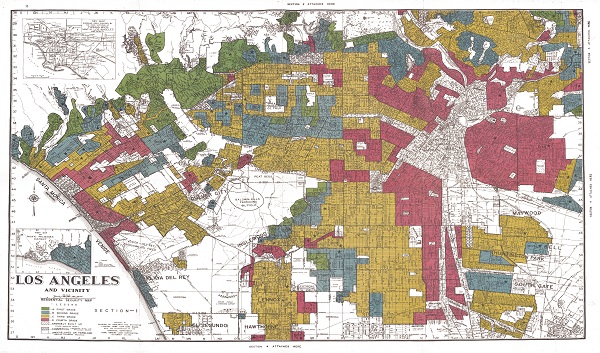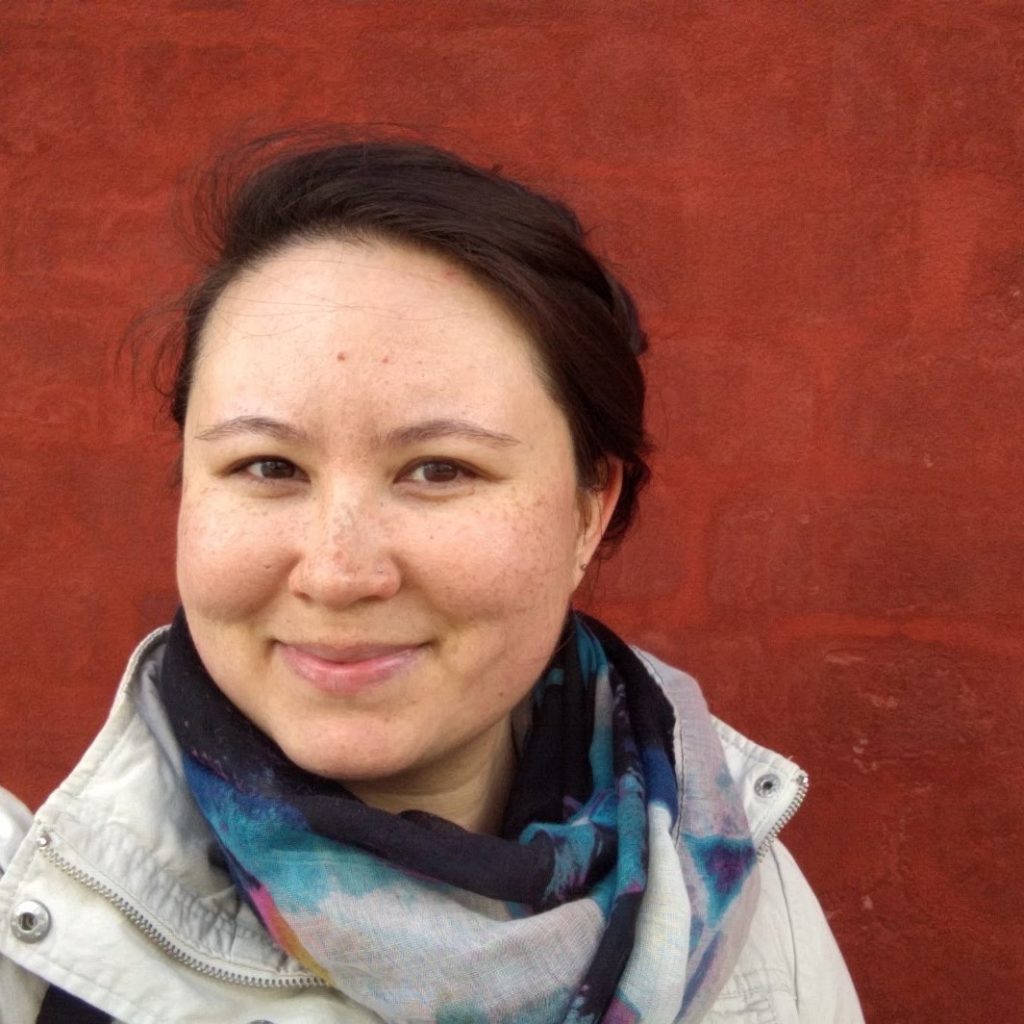In 2011, Virginia Tech hired me to help create a public history program and to teach digital history classes. That meant that public engagement and nontraditional publication were inherent parts of the job. Members of the department had undertaken public-facing digital work like this before, including the Digital History Reader and Virtual Jamestown, but there were no guidelines for how to evaluate it, other than as a side project or a post-tenure exploration—as much service as research. At that point, the 2010 white paper on publicly engaged scholarship from the National Council on Public History and the Organization of American Historians had just been released, laying out a set of principles. The department chair was aware of the report and supportive, but could offer few specifics for how the department could use it to evaluate faculty work.

The Home Owners’ Loan Corporation engaged in a practice known as “redlining” to determine eligibility for federal home loans. Maps (like this one of Los Angeles) were color-coded to grade “desirability,” with red sections listed as “hazardous.” The digital project Mapping Inequality allows users to click on individual neighborhoods to read HOLC comments, and much more. Mapping Inequality/CC BY-NC-SA 4.0
Digital history and digital humanities activities are increasingly important features of the academic landscape, but how to build a career that incorporates them, especially on the tenure track, where intellectual and bureaucratic changes can be slow, is still largely unclear. In my case, instead of emphasizing questions of medium, I focused on the broader challenge of balancing the inside game of institutional culture and the outside game of scholarly impact, which may be a helpful way for other scholars to think about this process.
In my first few years, the department discussed updating our tenure and promotion guidelines, and we drafted new language to incorporate digital and public work. Many colleagues backed new guidelines, but ultimately the faculty could not agree on any changes. That meant that we defaulted to the existing standard for tenure at a research university: a peer-reviewed book from a university press. The message I received, in word and in action, was “we value your public work, but make sure you get your book out.”
That wasn’t a surprise. I had never had any doubt that a book would be the centerpiece of my tenure case. Indeed, publishing a book on the effect of university growth on urban development was why I wanted to remain a historian after graduate school. I did not want to pull the double duty that so many public historians are forced to perform—publishing and managing community projects—but I was intrigued by the immediacy of communicating over the web and interpreting digital archives. A few digital projects seemed so compelling that I could not resist them.
There are few models for historians earning tenure based on digital or public work, especially at research universities.
Among urban historians, racial inequality and housing segregation have long been key concerns. Inspired by scholarship on the redlining maps of the Home Owners’ Loan Corporation (HOLC), I began taking research trips to the NARA II facility in College Park, Maryland, to explore what the collections held on HOLC. There were scores of the color-coded maps in the archives, I realized, and I began to learn of other researchers who were building collections of HOLC materials.
This project and another, on congressional-elections mapping, took time from work on my book, and I passed up ideas I had about articles I might have written, but I found the digital work invigorating, both important and immediate. I decided to take a risk on HOLC because it was so key to my research on cities, race, and space. I formed a collaboration with colleagues from the University of Richmond, Virginia Tech, Johns Hopkins University, and the University of Maryland. We assessed the existing paper archive, met via videoconference to plan and create our own digital archive, and distilled historiographical trends into short essays and discussed the meaning of features in the web interface we created.
It was clear that this project would have an impact when The Atlantic used my materials in the online version of Ta-Nehisi Coates’s “The Case for Reparations,” prompting numerous web features and driving traffic and downloads from all around the internet. Once we launched the Mapping Inequality site in October 2016, journalists from across the country got in touch, and colleagues contacted us about using materials in their research and in their classrooms. A TNT documentary series on segregation featuring Charles Barkley was next. Reporters from the Center for Investigative Reporting used our work for historical context as they documented present-day redlining.
Digital and public historians need to fight a two-front battle to change ideas about tenure. One is the “inside game” within the institution; the other is the “outside game” within our subfields and discipline. I discussed the project with my chair and mentors in my department. My third-year review, before the launch of Mapping Inequality, modestly acknowledged my digital work. The fifth-year review, after the launch, praised it at length. My colleagues were supportive enough that I felt I could make a case that this digital work would fill the role of the articles that often go along with a book project—that I could get some credit in the tenure case. The project had primary source material; engagement with secondary source material; historiographical analysis; intervention into scholarly debates; and post-publication review, including by established historians. All of the elements of a scholarly work were present, and the topic was close to my record of print publication because it was an organic outgrowth of the same research interests in urban history. I had chosen to focus on the subfield of urban history rather than the discipline-wide conversations on digital history, but I felt good about it. Whether I got tenure or not, I had made a solid mark in ways that mattered to me.
There are few models for historians earning tenure based on digital or public work, especially at research universities. The classic examples of the digital history world—the Ayerses and Cohens—mostly took on their digital work after tenure or in addition to their tenure books. There are a few more examples in the public history world, but we are still in the first generation of scholars who joined the faculty after Anthony Grafton and Jim Grossman acknowledged that it was time to think about and begin valuing public history. As the time approached to draft the dossier for tenure, my department also still lacked guidelines for giving credit. Thus, I worked to demonstrate the research value of Mapping Inequality, just as I would for a print project. I made presentations at conferences and to my department colleagues, I brought speakers to campus to present on digital and urban history, and I began publishing on the project and the research that came out of it. The AHA’s 2015 guidelines on evaluating digital scholarship helped shape expectations and gave some guidance that reinforced the work I was doing.
Digital and public historians need to fight a two-front battle to change ideas about tenure: within the institution and within our subfields and discipline.
My chair indicated that external letters were the most important elements of the tenure dossier. While there was the inside game of satisfying my colleagues, this is where the outside game of standing in my field came in. The committee generally wanted reviews from full professors at comparable or higher-ranked institutions. While I suggested a handful of scholars with digital expertise, for the most part my list of suggested reviewers consisted of subject-matter experts in urban history. After discussion with my colleagues and department chair, I prepared explanatory materials on Mapping Inequality to send out with my file to external reviewers when I prepared to apply for tenure. The work on redlining came out of my interest in urban development and inequality that had inspired my book Building the Ivory Tower: Universities and Metropolitan Development in the Twentieth Century (2017). This made it easier to explain the impact to external reviewers, who were already familiar with the broader research on redlining and understood the relationship between my print and digital work. In my tenure dossier’s introductory statement, I could also draw a clearer line to connect the dots of my key projects and pivot into my next book project, Chicago and the Remaking of American Real Estate, on the origins of the modern real estate regime.
Because so much of my work and its reception lives in the digital ether, my box of supporting materials of evidence was only half full. Some colleagues have two bankers’ boxes of folders stuffed with paper—articles, conference papers, course syllabi—but outside of a few key reviews and screenshots, I refused to print out all the material from the web. When I submitted my materials, the box felt lightweight and looked insubstantial, but I was confident of the inherent value of the work, ethereal though the information seemed.
I got word last year that I had been granted tenure, and it was a proud career achievement. There was no time to pause, however. As I shifted toward my post-tenure projects, my research engaged political history much more directly. The politics of the moment, centered on the midterm congressional elections, meant the time was right to push forward and release Electing the House of Representatives, 1840–2016 with the University of Richmond’s Digital Scholarship Lab. After all, it was time to start thinking about next steps, and I want digital work to feature in my case for promotion to full professor, as well.
LaDale Winling is associate professor of history at Virginia Tech. His new digital collaboration is the Chicago Elections Project. He tweets at @lwinling.
Tags: Features Tenure & Promotion Resources for Faculty Digital History

This work is licensed under a Creative Commons Attribution-NonCommercial-NoDerivatives 4.0 International License. Attribution must provide author name, article title, Perspectives on History, date of publication, and a link to this page. This license applies only to the article, not to text or images used here by permission.
The American Historical Association welcomes comments in the discussion area below, at AHA Communities, and in letters to the editor. Please read our commenting and letters policy before submitting.
Comment
Please read our commenting and letters policy before submitting.








